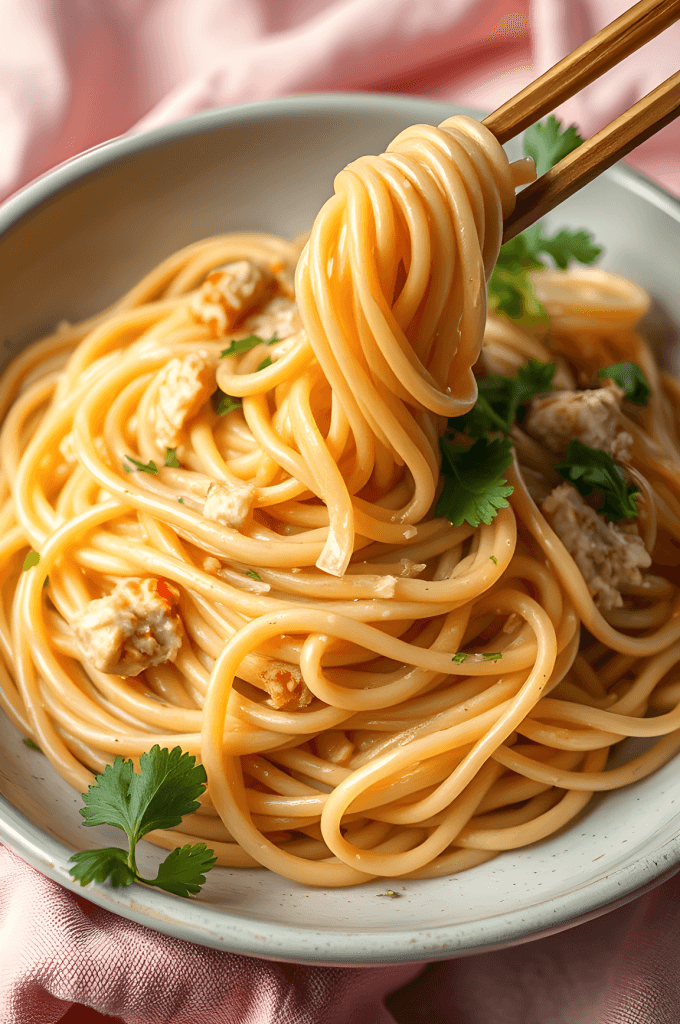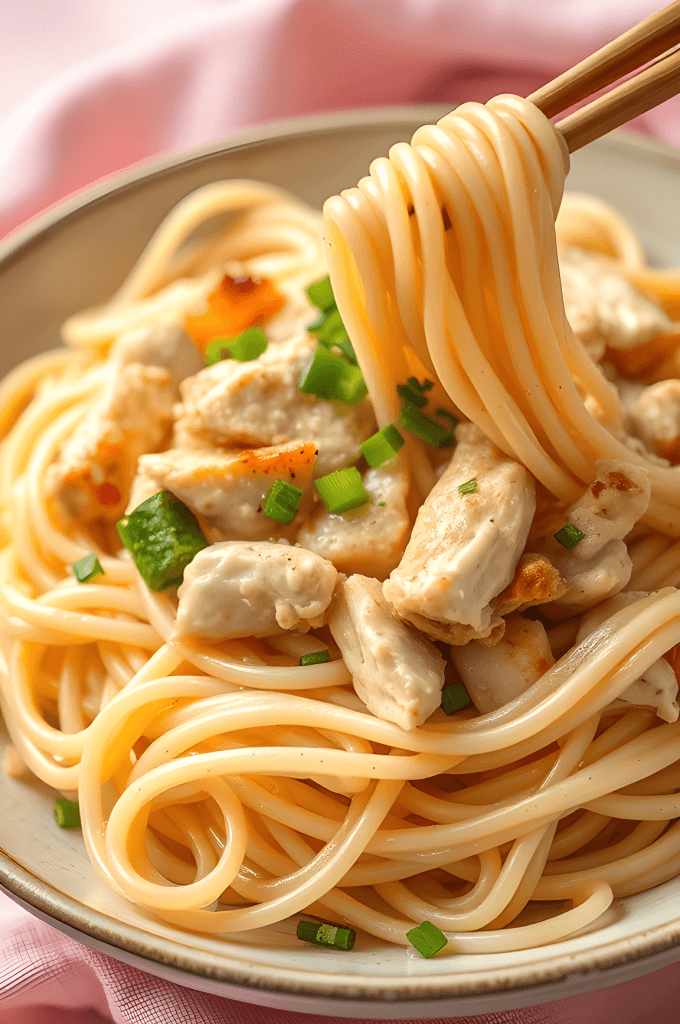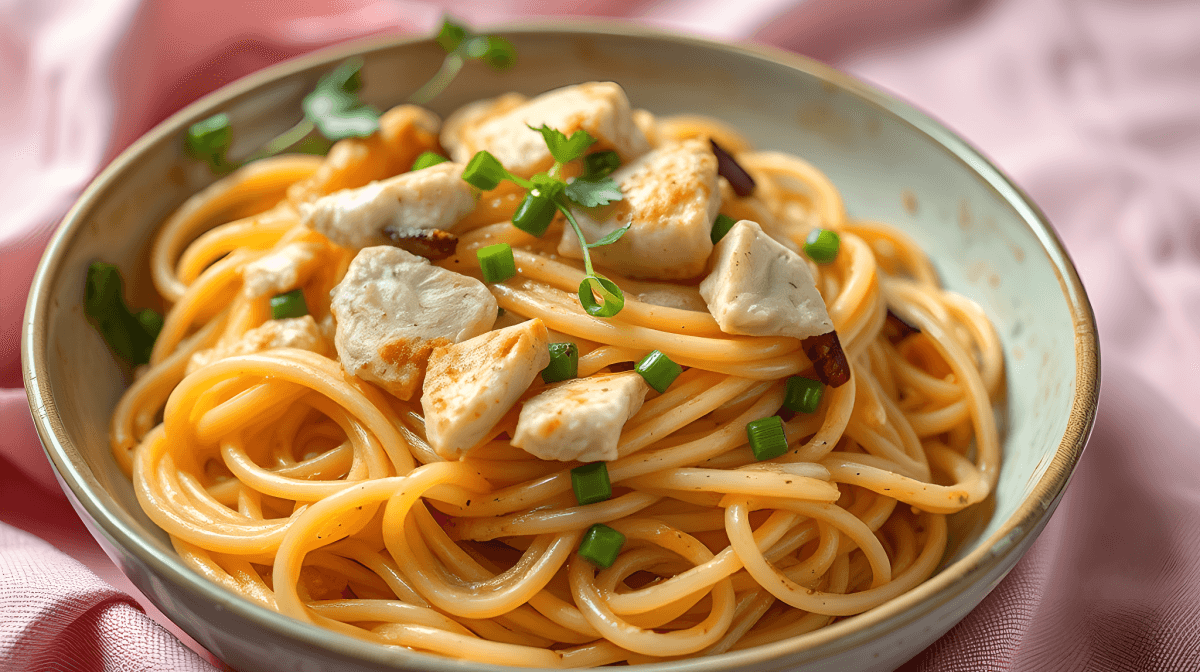Introduction
Growing up, one of my absolute favorite meals was stir-fried chicken noodles. It’s a dish that brings comfort, joy, and a wonderful blend of flavors in every bite. My grandmother, who was a brilliant cook, often made this dish using simple ingredients that were always packed with flavor. I remember the way the warm chicken, fresh vegetables, and savory sauce would come together in the wok, and we’d all sit around the table enjoying the perfect balance of textures.
Today, I’m excited to share this recipe with you – a modern take on the traditional stir-fried chicken noodles that I learned from her. It’s a perfect dish for busy weeknights or special family gatherings. With a mix of tender chicken, perfectly cooked noodles, and a blend of sweet, savory, and slightly tangy flavors, this dish is sure to become a staple in your kitchen too!
Whether you’re making this dish for yourself or for your loved ones, it’s guaranteed to impress with its fragrant aroma, vibrant colors, and irresistible taste. The beauty of this recipe is its simplicity – yet, the end result feels like a special meal. This stir-fried chicken noodles recipe is one that’s easy to prepare, with ingredients that you likely already have in your pantry.
Ingredients
For this recipe, you will need the following ingredients (serves 4):
- For the stir-fry:
- 2 boneless, skinless chicken breasts (sliced thinly)
- 200g (7 oz) egg noodles or any preferred noodles
- 2 tablespoons vegetable oil (or sesame oil for added flavor)
- 1 large carrot (julienned)
- 1 bell pepper (thinly sliced)
- 1 small onion (thinly sliced)
- 3 cloves garlic (minced)
- 2 tablespoons fresh ginger (minced)
- 1/2 cup broccoli florets (optional, for added crunch)
- For the sauce:
- 1/4 cup soy sauce (low-sodium preferred)
- 2 tablespoons oyster sauce
- 1 tablespoon hoisin sauce
- 1 tablespoon rice vinegar
- 1 teaspoon sugar
- 1 tablespoon sesame oil (optional, for flavor)
- 1/2 teaspoon crushed red pepper flakes (adjust to taste for spice)
- To garnish:
- 1 tablespoon sesame seeds
- 2 green onions (sliced)

Instructions
Step 1: Prepare the Noodles
- Begin by cooking your noodles according to the package instructions. If you’re using egg noodles, they typically cook in about 4-5 minutes. Once the noodles are tender, drain them well. To keep them from sticking together, drizzle them with a bit of oil and toss them gently to coat. If you’re using other types of noodles, make sure to follow the specific instructions for each variety to achieve the perfect texture.
- Tip: You can use any noodles you prefer for this dish, such as rice noodles, soba noodles, or even whole wheat noodles. The choice of noodles will slightly alter the texture and flavor, but each type will work beautifully in this recipe.
Step 2: Make the Sauce
- In a small bowl, whisk together all of the sauce ingredients: soy sauce, oyster sauce, hoisin sauce, rice vinegar, sugar, sesame oil, and crushed red pepper flakes. This combination of ingredients provides a balance of savory, slightly sweet, and tangy flavors, with a touch of heat.
- Tip: You can adjust the sweetness or tanginess of the sauce by adding more sugar or vinegar, depending on your taste preferences. The beauty of this recipe is that the sauce can be customized to suit your personal flavor profile.
Step 3: Stir-Fry the Chicken
- Heat 1 tablespoon of vegetable oil (or sesame oil for an additional layer of flavor) in a large wok or skillet over medium-high heat. Once the oil is hot and shimmering, add the sliced chicken to the pan. Stir-fry the chicken for about 3-4 minutes, or until it’s cooked through and golden brown on all sides. Use a spatula to break up any clumps of chicken, ensuring that the meat is evenly browned.
- Tip: For even better results, you can marinate the chicken in a bit of soy sauce, sesame oil, and a pinch of sugar for 10-15 minutes before cooking. This will infuse the chicken with more flavor.
- Once the chicken is cooked, remove it from the pan and set it aside. We’ll add it back later to finish the stir-fry.
Step 4: Stir-Fry the Vegetables
- In the same pan, add the remaining tablespoon of oil. Toss in the minced garlic and ginger, and stir-fry for about 30 seconds until fragrant. At this point, the kitchen will start to smell absolutely amazing!
- Add the thinly sliced onion, bell pepper, and julienned carrot to the pan. Stir-fry the vegetables for about 3-4 minutes, or until they are tender yet still retain a bit of crunch. If you’re using broccoli, add it during the last 2 minutes of cooking. This will allow the broccoli to stay bright green and crisp, adding texture and nutrition to the dish.
- Tip: Feel free to add other vegetables such as snap peas, baby corn, or mushrooms to suit your taste. A variety of vegetables not only adds flavor but also makes the dish more colorful and nutritious.
Step 5: Combine Everything
- Add the cooked noodles and the chicken back into the pan with the vegetables. Pour the prepared sauce over the mixture and toss everything together. Make sure that the noodles, chicken, and vegetables are well coated with the sauce. Continue stir-frying for an additional 2-3 minutes, allowing the flavors to blend and the sauce to soak into the noodles.
- Tip: If your noodles seem too dry during this step, you can add a small splash of water or chicken broth to help loosen the sauce and make it more fluid. The key is to make sure everything is coated and the sauce sticks to the noodles perfectly.
Step 6: Garnish and Serve
- Once everything is well combined and heated through, remove the pan from the heat. Transfer the stir-fried chicken noodles to a serving platter or individual bowls. Garnish with sesame seeds and fresh green onions for a touch of color and texture.
- Serve your stir-fried chicken noodles immediately while they are still warm. The dish is best enjoyed fresh, as the noodles retain their perfect texture when served right away.

Tips for the Perfect Stir-Fried Chicken Noodles
- Noodle Choices: While egg noodles are traditional, you can easily substitute them with rice noodles, soba noodles, or even whole wheat noodles for a healthier twist. Each type of noodle brings its own unique texture and flavor to the dish.
- Vegetable Variations: Feel free to experiment with other vegetables like snap peas, baby corn, or even spinach for added variety and nutrition. The great thing about stir-fry is that you can use whatever you have on hand, and it will still taste fantastic.
- Add More Protein: For extra protein, you can add scrambled eggs, shrimp, or tofu to the stir-fry. If you’re using tofu, be sure to press it first to remove excess moisture before pan-frying it for a crisp texture.
- Customize the Sauce: Adjust the level of sweetness, tanginess, and saltiness in the sauce to match your taste preferences. For a spicier kick, add more red pepper flakes or a drizzle of chili oil.
- Wok vs. Skillet: If you have a wok, use it! A wok’s high sides and wide surface are ideal for stir-frying, as they allow you to toss ingredients easily and evenly. However, if you don’t have one, a large skillet will work just fine.
Why This Chicken Noodles Recipe is a Winner
This stir-fried chicken noodles recipe is not only quick and easy to prepare, but it also balances protein, vegetables, and carbohydrates in every bite. The combination of soy sauce, hoisin sauce, and sesame oil gives the dish a deep, savory umami flavor, while the freshness of the vegetables adds a delightful crunch. Whether you’re cooking for your family or impressing friends at a dinner party, this dish will surely be a crowd-pleaser!
Health Benefits of Stir-Fried Chicken Noodles
- Protein-Packed: Chicken is an excellent source of lean protein, helping to build muscle and repair tissue. Pairing it with the vegetables provides a balanced, satisfying meal.
- Rich in Nutrients: Vegetables like carrots, bell peppers, and broccoli are high in essential vitamins and minerals such as Vitamin A, Vitamin C, and fiber. These nutrients help boost the immune system and improve overall health.
- Customizable: This dish can be made healthier by using whole wheat noodles or adding more vegetables. It’s a great way to sneak in more greens and keep the dish light yet filling.
- Low in Fat: With minimal oil used in stir-frying and the option to use lean chicken, this dish is a healthy alternative to greasy takeout options.

Additional Variations for Your Stir-Fried Chicken Noodles
While this recipe is already amazing as is, here are some variations to keep things fresh and exciting:
- Spicy Stir-Fry: Add a tablespoon of chili paste or sriracha sauce to the sauce mixture for an extra spicy kick. You can also top the finished dish with some fresh chopped chili peppers for added heat.
- Sweet and Sour: For a sweet and sour twist, add a tablespoon of pineapple chunks to the stir-fry along with a splash of rice vinegar and a bit of honey or sugar. This will give the dish a tangy, tropical flavor.
- Vegetarian Version: Swap out the chicken for tofu, tempeh, or a medley of your favorite vegetables for a satisfying vegetarian option. The sauce will complement these alternatives beautifully.
- Add More Umami: If you love the rich, savory flavor of umami, try adding a few drops of fish sauce or a sprinkle of miso paste to the sauce for an added depth of flavor.

